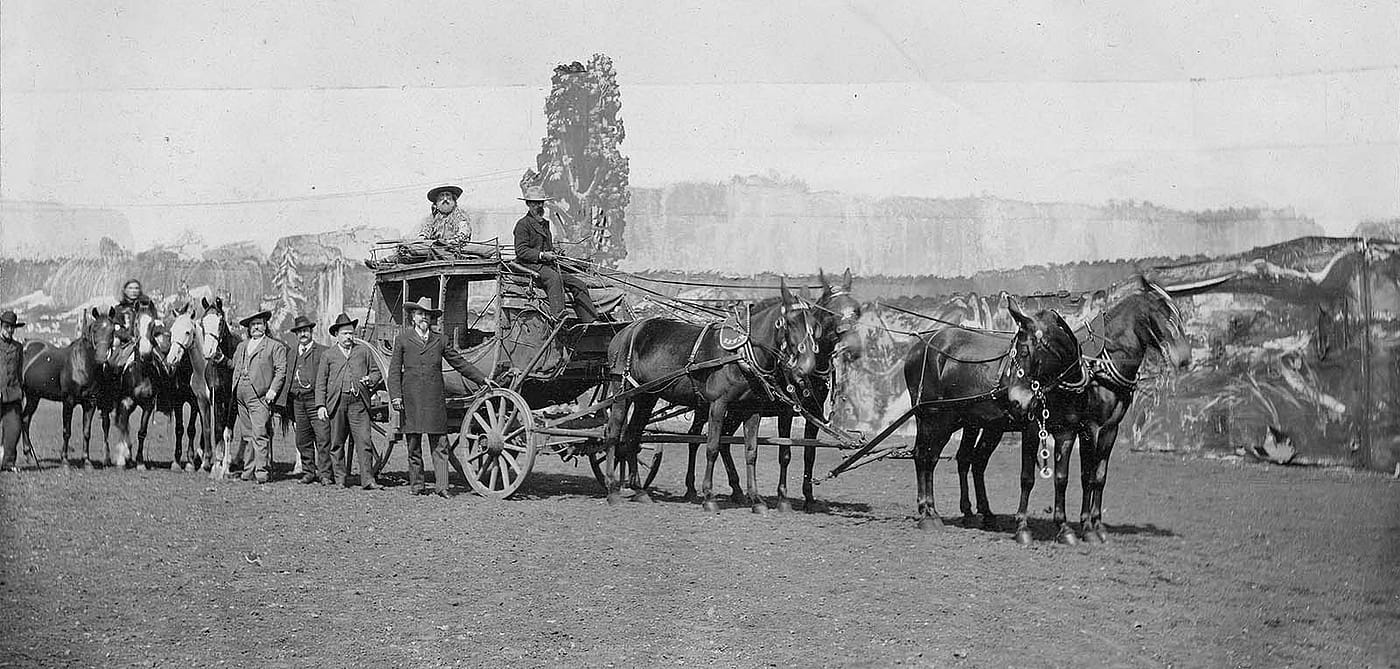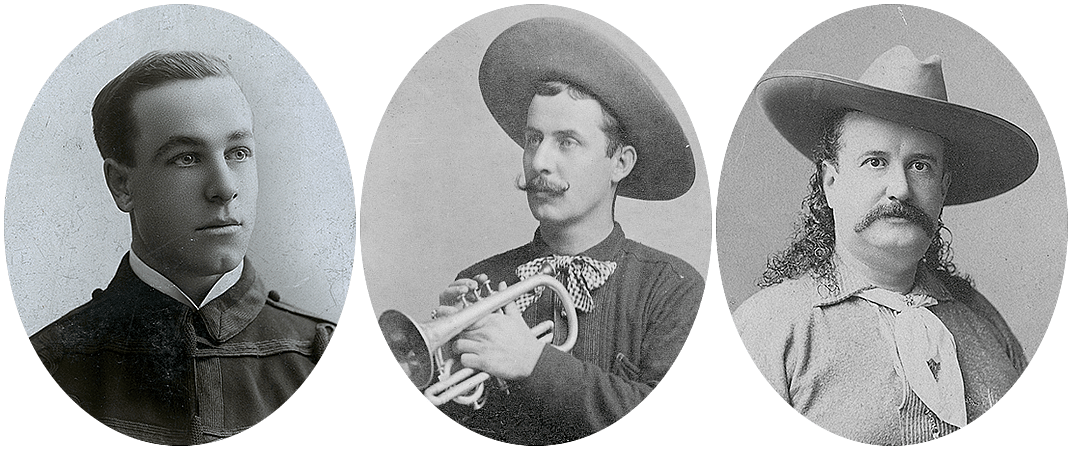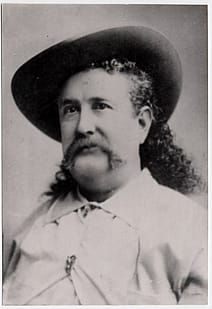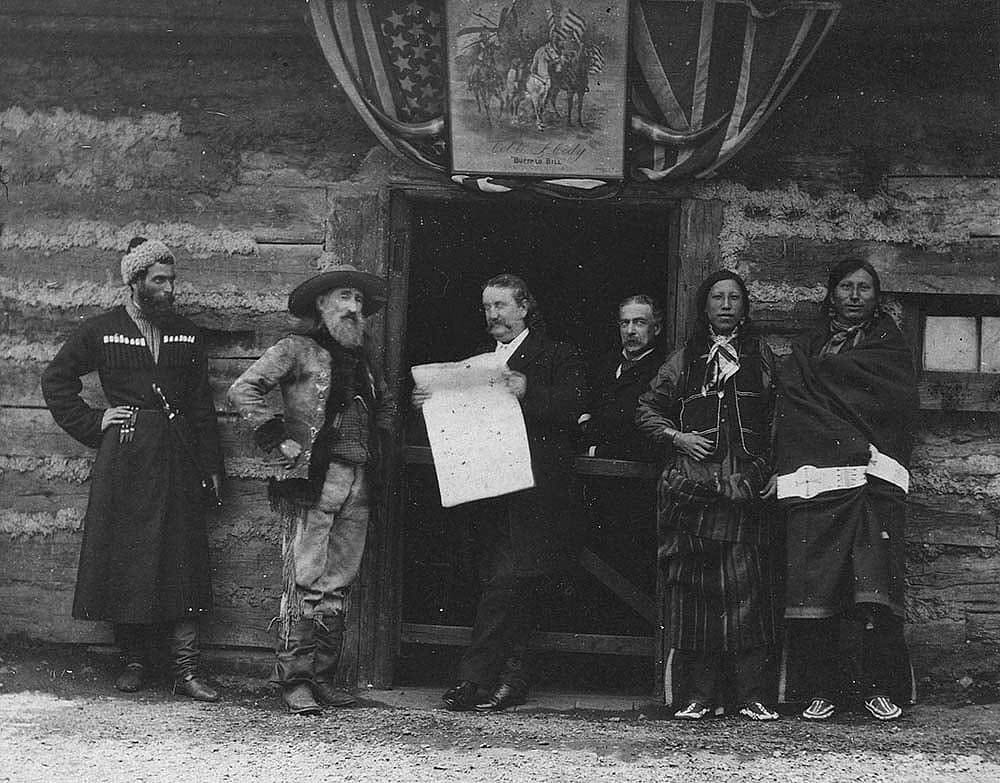
Unmasking the Mysterious Major Burke – Points West Online
Originally published in Points West magazine
Winter 2012
Unmasking the Mysterious Major Burke
By Chris Dixon
Major John M. Burke first met William F. “Buffalo Bill” Cody in early September 1873. At the time, Burke managed the career of the Italian-born actress and dancer, Giuseppina Morlacchi. His client had just married John “Texas Jack” Omohundro, one of the co-stars with Cody in Cody’s Buffalo Bill Combination stage production, Scouts of the Plains. Burke traveled with the newlyweds to join the company in Chicago immediately after their wedding in Rochester, New York—a meeting that would define the subsequent course of both men’s lives.


Only Burke (above right), Cody himself, marksman Johnny Baker (left), who was Cody’s informally adopted son, and bandmaster William Sweeney (center) were involved with Buffalo Bill’s Wild West during the entire period that it operated. Indeed, when the Wild West Company was officially formed in Jersey City, New Jersey, February 28, 1887, Burke, as first employee, was appointed General Manager “to hold office during the pleasure of the President and Vice-President.”
It was a role that Burke clearly relished. He served as advance agent, location scout, talent scout, press agent, and publicity manager. He directly managed a staff that numbered as many as nine individuals; he churned out programs, handbills, and advertising booklets; he organized and staged publicity events and photo opportunities; and he oversaw advertising campaigns that produced as many as a half million posters in a season. He supplied interviews, and wrote and planted copy with local newspapers, cultivating good relationships with the gentlemen of the press. Burke’s extravagant expense accounts were the bane of the life of company treasurer Jule Keen.
When the Wild West was scheduled to play Chicago to coincide with the 1893 World’s Fair, Burke was an obvious choice to compile Cody’s biography “with the authority of General W.F. Cody (Buffalo Bill)” that was issued to coincide with the event under the title Buffalo Bill from Prairie to Palace.

Given that the entire focus of his career for more than forty years was the promotion of the iconic persona of Buffalo Bill, it is perhaps surprising that we know so little about John Burke’s own life. An examination of the few comments he made in public about his background would lead one to suspect that the “Mysterious Major Burke” may have had something to hide.
Burke was never a major in any meaningful military sense of the term. He was known as “Arizona John,” although he claimed no direct connection to Arizona. At various times he did, however, claim to be from Indian Territory, Ireland, Maryland, New York, Philadelphia, Virginia, and Washington D.C.! When he registered at a hotel, he would place the initials USA after his signature—a practice that was not uncommon among army officers.

When he was once challenged as to whether or not he was claiming to be a serving member of the U.S. Army, Burke immediately responded that, in his case, the initials stood for the United States of America as he never stayed in one place long enough to regard it as home. Consequently, he claimed the whole country as his home. This anecdote suggests a ready wit, and its source, This Way to the Big Show, was the autobiography of Dexter Fellows, a protégé of Burke’s who went on to have a distinguished career in public relations, promotion, and advertising, but who—like many—started out with Buffalo Bill’s Wild West.

Fellows provides a number of insights into Burke’s character. He describes a man who “…always appeared to be the picture of sartorial perfection but to my knowledge he never wore a shirt. Fastened around his neck was a false white bosom of standard linen, and attached to the sleeves of his undershirt were white cuffs.” Fellows writes of a lavish entertainer who always smoked the best cigars and who had an astonishing capacity for alcohol, although he adds, “I never saw him intoxicated.” He stresses that Burke was generous to a fault, “the delight of cadgers and panhandlers” and relates that “Wherever he went there was a coterie of impecunious characters around him for whom he always had a drink or a meal or a dollar. In fact, his hand was habitually in his pocket.”
Interestingly, however, Fellows also tells a story which contains a detail that may help us unmask the mysterious Major Burke:
The setting was Anderson’s Café, across from Madison Square Garden, New York. Fellows tells how the Major was regaling an assembled group of newspapermen with the tale of his exploits at the Battle of Wounded Knee and of the Indians that he had killed during that particular conflict.
Just then, one of the company, whom everyone had assumed to be asleep, raised his head from the bar and remarked, “Burke, you know damn well that the only Indian you ever killed was a Delaware Indian you worked to death on your grandfather’s farm outside Wilmington.” Fellows confessed that he laughed aloud at the jibe and clearly understood that by doing so, he had hurt Burke’s feelings. Fellows further states that he believed Burke never fully forgave him. The reaction would be difficult to comprehend, unless of course, it had touched a nerve. Could there be a grain of truth in it?

A review of Federal Census records, local business directories, passenger lists from immigrant ships, registers of deaths, and Catholic parish records for Wilmington, Delaware, show that there is more than a grain of truth to the patron’s disparagement of Burke’s family. The various documents provide definitive proof of John M. Burke’s date and place of birth, and family background, which was, for the most part, a far cry from Indian Territory, Ireland, Maryland, New York, Philadelphia, Virginia, Washington D.C., and other places he claimed as home.
It is now possible to say with certainty that John Burke’s paternal grandfather was an Irish merchant named Thomas Burke. The elder Burke entered the United States by way of New York in 1833 with his wife, Ellen, when both were already more than 40 years of age. Within a year, they had been joined by three sons, a daughter-in-law, and two grandchildren; by 1840, they were settled in the Brandywine Hundred, New Castle, Delaware.
In 1838, their 27-year-old middle son, Peter, married a Swiss immigrant named Mary Frances Raymond, in the Cathedral of St. Peter, Wilmington, Delaware. The couple subsequently had two sons: Thomas, born August 13, 1840, and John, born April 10, 1842, both baptized in the same church where their parents were wed. Their second son would grow up to be the general manager of Buffalo Bill’s Wild West.
The U.S. Federal Census record for the First Ward of Wilmington, Delaware, in 1850, shows 8-year-old John Burke “attending school.” The record for the same ward in 1860 has 18-year-old John Burke, whose occupation is unfortunately an illegible scrawl in the record book, residing there with his Irish-born father and Swiss-born mother. By 1870, 28-yearold John M. Burk had, for the first time, added a middle initial to his moniker and dispensed with the final “e” in “Burke.” His occupation was listed as “theatre manager,” using the English rather than the American spelling, a record that confirmed he was a U.S. citizen more than 21 years of age, had parents who were of foreign birth, and that he was then living with his 87-year-old Irish-born grandfather, Thomas Burke.

There is an old saying that every good lie has some truth to it. Having established the truth about Burke’s family background, it is interesting to note that he did incorporate one factual element in two stories that he manufactured to generate positive publicity for William F. Cody: That element was his brother Thomas.
In 1876, Burke sent a letter to various newspapers, which he claimed he had received from his brother, Thomas. In it, Thomas describes himself as a scout in the Black Hills, extols the virtues of the region, and calls for Buffalo Bill to come out there and deal with the Indians. Some twenty-five years later, when Cody was developing a business interest in mining, a second letter was published, once again purportedly from Burke’s brother Thomas. By then, Thomas was allegedly a mining engineer, and in the letter, he is lavish in his praise of Arizona’s mining industry.
Needless to say, official records show the real Thomas Burke living in Wilmington, Delaware, throughout this period. He had become a successful butcher, with his own thriving business in a prime location, was married to an Irish immigrant, Julia Lambert Burke, and was the father of three daughters and a son.
Everything about Burke’s family suggests hard work, honest endeavor, and respectability. The truth may not be glamorous, but it is certainly not something about which he could have any reason to be ashamed. Could there be something else that the Mysterious Major was hiding about his background?
- Might he have served in the confederate army during the Civil War? There certainly was a 21-year-old private John M. Burke of Company H, First Maryland Regiment, CSA, captured at Antietam and subsequently paroled. The record of this particular Burke shows him as a resident of Wilmington, Delaware, born in England, and whose previous occupation was that of a shoe maker. If this is the John M. Burke who later became the Wild West’s General Manager, then we can add England to the list of places that he claimed for his home.
- Might he have become estranged from his family because he renounced the Catholic faith in which he was brought up, and married a Protestant? There is certainly a record of a John M. Burk, of New Castle County, Delaware, marrying a Mary J. Ford in New Castle Methodist Episcopal Church on Christmas Day 1866. It has not yet been possible to establish whether either of these references relates to the John M. Burke who was a long-term associate of William F. Cody.
- Beyond his Civil War record—if he had one—and his marital status, there is also the issue of his theatrical career prior to his first encounter with Cody. Was Burke a juggler, acrobat, dancer, black-faced minstrel, character actor, associate of Frank Richmond (the Wild West’s arena announcer in the first few years it operated)—as various sources have claimed?
- The Mysterious Major’s mask may have slipped somewhat, given that we now know the date and place of his birth, but there are a great many mysteries still to unravel before we can conclude that he has finally been unmasked.
About the author
Chris Dixon, senior research fellow in the Department of Modern Languages at the University of Strathclyde in Glasgow, Scotland, is a member of the United Kingdom’s Chartered Institute of Linguists and holds two master’s degrees from Glasgow University. Dixon edited Four Years in Europe with Buffalo Bill, a book by Charles Eldridge Griffin, originally published in 1908, and Buffalo Bill from Prairie to Palace, a book by John Burke originally published in 1893.
Post 255
Written By
Nancy McClure
Nancy now does Grants & Foundations Relations for the Center of the West's Development Department, but was formerly the Content Producer for the Center's Public Relations Department, where her work included writing and updating website content, publicizing events, copy editing, working with images, and producing the e-newsletter Western Wire. Her current job is seeking and applying for funding from government grants and private foundations. In her spare time, Nancy enjoys photography, reading, flower gardening, and playing the flute.











